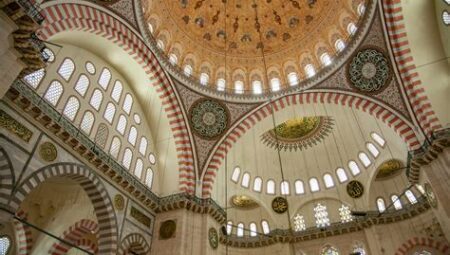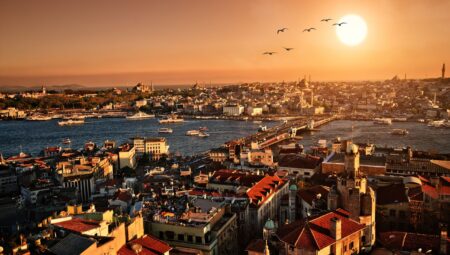Discover the rich history, symbolism, and artistry of the Blue Mosque’s stunning decorations, and explore tips toIstanbul, a city where East meets West, is a treasure trove of spiritual landmarks steeped in rich history and captivating artistry. Among its most iconic sites is the majestic Blue Mosque, a masterpiece that has drawn visitors from around the globe. This article serves as your comprehensive guide to exploring the allure of Istanbul’s spiritual heart. Delve into the intricate history behind the mosque’s stunning decorations, uncover the symbolism embedded in its artistry, and learn about the traditional techniques that bring these creations to life. Discover how the mosque’s ornate features reflect deeper Islamic culture and beliefs, while also experiencing the mesmerizing impact of light and color within its sacred interiors. Whether you’re a seasoned traveler or a first-time visitor, our insights and tips will enhance your journey through this architectural wonder, making your visit to Istanbul an unforgettable spiritual experience.
The History Behind The Blue Mosque’s Stunning Decorations
The Blue Mosque decorations meaning can be traced back to the early 17th century, when the mosque was commissioned by Sultan Ahmed I. Designed by the architect Sedefkâr Mehmet Ağa, the mosque represents a pivotal moment in Ottoman architecture, merging traditional styles while introducing innovative artistic elements. The intricate decorations serve not only as aesthetic enhancements but also carry deep spiritual significance.
Much of the inspiration for the mosque’s interior design came from earlier architectural masterpieces, particularly the Hagia Sophia. This homage solidified the Blue Mosque’s status as a continuation of Istanbul’s storied architectural legacy. The use of vibrant tiles, predominantly in blue and white hues, is where the mosque earns its nickname. These tiles, crafted in Iznik, are rich in symbolic representation, embodying concepts like eternity and paradise, which are central to Islamic belief.
The decorative program of the mosque also reflects the Islamic ideals of beauty and devotion. The calligraphic inscriptions and geometric patterns are meticulously designed to inspire contemplation and humility among visitors. It is important to note that each decorative element is intentional, aligning with both spiritual and cultural nuances of the time.
The history of the Blue Mosque decorations meaning is deeply intertwined with Ottoman history, culture, and religion. The stunning work of art is not merely for visual pleasure but serves as a timeless reminder of the values and beliefs that shaped its creation.
Exploring The Symbolism Of Blue Mosque Decorations Meaning
The Blue Mosque decorations meaning goes beyond mere aesthetics; they are deeply intertwined with Islamic beliefs and cultural values. Each decorative element serves as a visual representation of spiritual concepts and religious principles, which together create an atmosphere conducive to worship and reflection.
One of the prominent symbols found in the Blue Mosque decorations is the use of geometric patterns. In Islamic art, these intricate designs are often seen as a reflection of the infinite nature of Allah. The repetition of shapes and forms signifies the endlessness of God’s creation, inviting worshippers to contemplate the divine beyond the material world.
Furthermore, floral motifs and arabesques are prevalent in the mosque’s interior, symbolizing paradise. These themes are rooted in the Quranic descriptions of heaven, which highlight lush gardens and abundant flora. By incorporating natural elements, the Blue Mosque decorations meaning subtly reminds visitors of the harmonious relationship between humanity and the divine.
An additional layer of symbolism can be found in the selection of colors used in the mosque’s decorations. The predominant blue hues are emblematic of tranquility, peace, and devotion, aligning with the mosque’s purpose as a space for prayer and meditation. As sunlight filters through the stained glass windows, it casts colorful reflections, emphasizing the divine presence and enriching the spiritual experience.
To summarize, the Blue Mosque decorations meaning serve as a profound reminder of Islamic spirituality, aiming to elevate the visitor’s experience. Understanding these symbols enhances one’s appreciation for the artistry and cultural significance of this architectural masterpiece.
Traditional Techniques Used In The Blue Mosque’s Artistry
The artistry of the Blue Mosque is renowned for its intricate and stunning designs that reflect the rich cultural heritage of Islamic art. These remarkable creations are a testament to the traditional techniques employed by skilled artisans during its construction in the 16th century.
One of the most prominent techniques used in the Blue Mosque decorations meaning is tilework. The mosque features thousands of hand-painted tiles, primarily in shades of blue, green, and turquoise, crafted in İznik, a town famous for its ceramics. These tiles not only serve as decorative elements but also convey deeper spiritual meanings through their designs and colors, illustrating the connection between art and faith.
Calligraphy is another essential element of the Blue Mosque’s artistry. Verses from the Quran are intricately inscribed in beautiful script, enhancing both the visual appeal and the spiritual significance of the mosque. The use of calligraphy in religious spaces symbolizes the word of God, bridging the gap between the divine and the material world, offering a profound spiritual experience for visitors.
Moreover, the technique of muhcacak, or the art of stucco work, is prevalent throughout the mosque’s interiors. Highly detailed and ornate designs crafted from plaster add depth and texture to ceilings and walls, creating an immersive atmosphere that invites contemplation. This craftsmanship reflects the skill and dedication of the artisans who believed that every detail contributed to the overall worship experience.
The integration of geometric patterns plays a vital role in the mosque’s artistic expression. These patterns draw inspiration from mathematical principles found in nature and serve to symbolize the infinite nature of Allah. The repetitive designs evoke a sense of harmony and unity, entrancing observers and guiding them toward contemplation of the divine.
The mastery of these traditional techniques in the Blue Mosque’s artistry not only enhances its beauty but also communicates the Blue Mosque decorations meaning through layers of symbolism, inviting travelers to engage more deeply with Istanbul’s spiritual heritage.
How Blue Mosque Decorations Reflect Islamic Culture And Beliefs
The Blue Mosque decorations meaning is deeply rooted in Islamic culture and embodies a rich narrative of faith, art, and devotion. Every detail within the mosque’s ornate design serves a purpose, contributing to both aesthetic beauty and spiritual significance. From the intricate tile work to the carefully designed motifs, these decorations encapsulate the essence of Islamic teachings.
At the heart of the Blue Mosque decorations meaning are geometric patterns and arabesques that symbolize the infinite nature of Allah. These repeating patterns serve as a reminder of the divine presence, illustrating the belief that everything in the universe is created by God. The use of such patterns reflects the Islamic principle of unity and the interconnectedness of all creation.
Furthermore, the colors used in the mosque’s decorations hold significant meanings. The predominant use of blue is not arbitrary; it represents paradise and spiritual enlightenment. The various shades of blue, alongside green, which is often associated with the Prophet Muhammad, reinforce the spiritual journey that believers embark upon. This connection to nature and spirituality is vital in Islamic art, where depictions of living beings are often avoided to focus on the Creator’s majesty.
Moreover, calligraphy plays a crucial role in the Blue Mosque decorations meaning. Verses from the Quran adorn the walls, offering messages of hope, guidance, and divine wisdom. This incorporation of scripture not only beautifies the space but also invites worshippers to reflect on their beliefs and draw closer to their faith. The delicate artistry of Islamic calligraphy elevates the significance of the texts, transforming them into visual forms of worship.
The Blue Mosque decorations meaning transcends mere ornamentation. It is a harmonious blend of art and spirituality that reflects the values and principles of Islamic culture. Each decorative element serves to enhance the worship experience, inviting visitors and worshippers alike to reflect on their relationship with the divine and the beauty of creation.
The Impact Of Light And Color In The Blue Mosque Interiors
The interplay of light and color within the Blue Mosque profoundly influences the overall atmosphere and signifies deeper meanings embedded in its architecture. The mosque, designed by the famous architect Mimar Sinan, harnesses natural light in such a way that it transforms the interiors throughout the day, creating a dynamic spiritual experience for visitors. This mastery over light serves not only an aesthetic purpose but also enriches the Blue Mosque decorations meaning, weaving together spirituality and artistry.
As sunlight cascades through the intricate stained glass windows, it bathes the vast prayer hall in a myriad of colors. This luminous effect creates an ambiance of serenity, encouraging contemplation and reflection among worshippers and tourists alike. The glass designs often depict floral and geometric patterns that are characteristic of Islamic art, reinforcing the mosque’s role as a sacred space. In this way, the colors and light not only enhance the beauty of the interiors but also resonate with Islamic beliefs, which emphasize the divine nature of light.
The use of color is also strategically employed to highlight specific features of the mosque. For instance, the prominent blues and turquoises are reminiscent of the sky and the sea, symbolizing infinity and the transcendent qualities of the divine. This connection between color and meaning enriches the visitor’s understanding of the Blue Mosque decorations meaning while allowing them to experience the spiritual essence of the space.
Overall, the interaction of light and color in the Blue Mosque serves as a visual representation of theological concepts, illustrating how architecture can convey profound meanings and emotional states. As you stroll through the mosque, take a moment to observe how these elements come together to create a sanctuary that invites both reflection and awe.
Visiting Tips To Enhance Your Experience Of The Blue Mosque
Visiting the Blue Mosque, known for its breathtaking architecture and vibrant Blue Mosque decorations meaning, can be a memorable experience. Here are some tips to ensure your visit is both enjoyable and enlightening.
- Dress Appropriately: As a place of worship, it is essential to dress modestly. Women should cover their hair, and both men and women should wear clothing that covers shoulders and knees. Scarves are often provided at the entrance for those who may not have one.
- Timing Your Visit: To avoid crowds, visit early in the morning or later in the afternoon. Morning prayers and special events can make your visit more crowded during peak times.
- Guided Tours: Consider joining a guided tour to learn more about the Blue Mosque decorations meaning and their cultural context. Knowledgeable guides can provide insights into the history and significance of the mosque that you may not get on your own.
- Respect Prayer Times: Remember that the Blue Mosque is an active place of worship. Be mindful and respectful during prayer times, which can often be found posted at the entrance.
- Photography Etiquette: While photography is usually allowed, it’s best to ask for permission before taking pictures of people, especially during prayers. Note that flash photography may be prohibited inside to maintain the sanctity of the space.
- Explore the Surroundings: Take some time to walk around Sultanahmet Square, where the mosque is located. Discover nearby landmarks such as the Hagia Sophia and Topkapi Palace to enrich your understanding of Istanbul’s rich history.
By following these tips, you can immerse yourself in the serene atmosphere of the Blue Mosque and appreciate its awe-inspiring Blue Mosque decorations meaning on a deeper level.
Frequently Asked Questions
What are some of the most iconic spiritual landmarks in Istanbul?
Some of the most iconic spiritual landmarks in Istanbul include the Hagia Sophia, the Blue Mosque, and the Suleymaniye Mosque.
What makes the Hagia Sophia unique?
The Hagia Sophia is unique for its impressive architecture and historical significance, having served as both a church and a mosque, and now functioning as a museum.
Are there any notable pilgrimages or spiritual rituals associated with these landmarks?
Yes, many visitors partake in the tradition of praying at the Blue Mosque and observing the call to prayer, which is an integral part of Istanbul’s spiritual life.
Is there an entrance fee to visit these landmarks?
While some landmarks like the Hagia Sophia are free to enter, others, such as the Basilica Cistern, may have a small entrance fee.
What is the best time to visit these spiritual landmarks?
The best time to visit is during the early morning or late afternoon to avoid crowds and experience a more serene atmosphere.
How can visitors be respectful when visiting spiritual sites?
Visitors should dress modestly, remove shoes where required, and maintain a respectful silence to honor the spiritual significance of these sites.
Are there guided tours available for spiritual landmarks in Istanbul?
Yes, there are many guided tours available that focus on the rich history and spiritual significance of Istanbul’s landmarks, providing in-depth knowledge and context.




